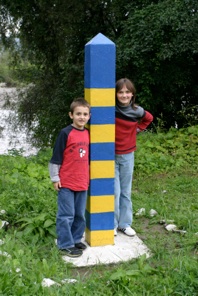2007

There are still many parts of Ukraine that I haven't visited although, with each trip, they become fewer. One place I'd been wanting to visit is Zakarpattya (Transcarpathia), the land across the mountains – in this case, on the other side of the Carpathians. It is an interesting area, ethnically very mixed (Ukrainians, Lemky, Slovaks, Rumanians and Hungarians), and the Ukrainian spoken there is a distinct dialect. I had travelled across this region on my very first trip to Ukraine in 1989, when the Soviet Union began at the town of Chop, but it had been the middle of the night, and I hadn't seen anything.

We drove further along the Tysa river, which forms the border with Rumania, and stopped at a border post to have our picture taken with our feet in both countries. Rumanian looked quite lovely – the mountains seemed higher, and the forests more lush, just across the border. Villages in this area tend to be ethnic in nature – mostly Rumanian, or mostly Hungarian, or mostly Ukrainian. We saw many well built towns, and visited a lovely wooden Rumanian church, all dark wood, with tall wooden towers.

We next stopped in Dilove, a village on the Tysa and near the city of Rakhiv. In 1887 Austro-Hungarian geographers carried out some calculations and determined that the geographical center of Europe was located at 48°45′N, 18°55′E. There, in Dilove, they placed a monument on which is inscribed in Latin: "Locus Perennis Dilicentissime cum libella librationis quae est in Austria et Hungaria confectacum mensura gradum meridionalium et paralleloumierum Europeum. MD CCC LXXXVII." The Soviets later added another marker, and someone since has built a bar/restaurant/museum/tourist complex/car park. Sadly, or not, we were there in the off season and there wasn't much activity. The bar/museum did have a fine collection of door keys and flat irons, though.

We drove on through beautiful, if quite wet scenery, deeper into the mountains, and soon arrived in Vorohta, where I had spent eight summers at camp. We stopped in to see my friend, the doctor/chauffeur/mushroom hunter Slavyk. in his flat just near the town school. It was full of mushrooms in varying stages of preparation, both dried and marinated. Slavyk treated us to tea and chocolates, and spoke at length about all things mushroom. He has been my mushroom connection for years, and came through again, but just barely. The mushrooms were quite late this year, the harvest had been poor, and only in the past week or two had he found them in any numbers.

We kept driving through the mountains, along the river Prut, bringing back memories, stopping to shop at the market in Yaremche, and then heading on to the long road home to L'viv.
Main UKRAINE Page
___________
-
1.After eight summers spent in Vorohta at summer camp, I had gotten to know the area quite well, and each corner held memories for me. What I still recall most is the first time Daryna came to Vorohta, accompanying her father when he was coming to pick me up. All she knew was that they were going to get her godmother from America. She sat, nose pressed to the window, and, as they arrived in the heart of the mountains, looked around and said to her father "America is really, really beautiful!"
-
2.Handcrafts cost more the further you buy them from their source. If you know the crafters, you can buy from them. If not, there is the big market in Kosiv. Vendors buy stuff there to sell in Yaremche; others yet will take the goods to L'viv or Kyiv. The rices seem to double each step of the way........ I picked up gifts for my nieces (leather purses), some nice embroidery for my mother (sunflowers), and a set of five rushnyky for my monk friends at the Jampot in the UP.
Palanok castle, Mukachevo
Zakarpattya




